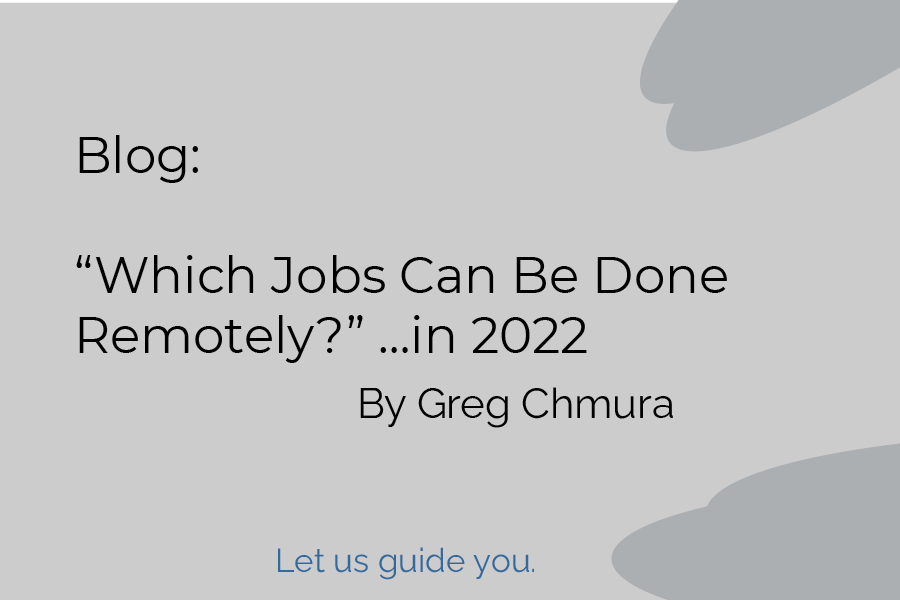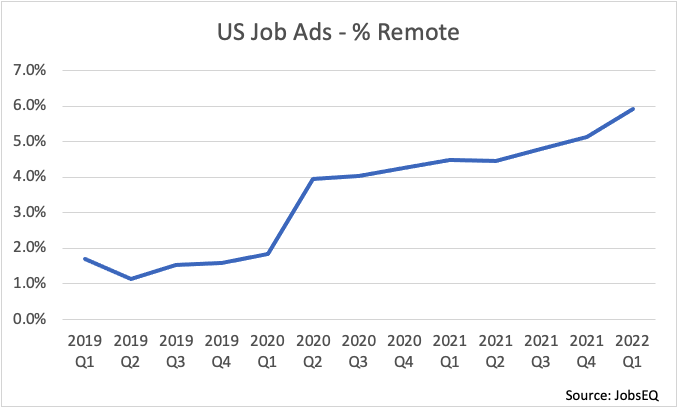'Which Jobs Can Be Done Remotely?' ...in 2022

The COVID-19 pandemic triggered shutdowns in early 2020 which in turn forced many employers to place employees in work-from-home situations. At that time, we published an analysis that looked at which occupations were most conducive to remote work. That analysis, however, was based on source data that had been gathered prior to the pandemic.
Two years later, much has changed. As we’ve written recently, many employees have begun to go back to traditional places of work as pandemic fears have eased; but in a concurrent trend, remote work options have continued to rise in prominence in job ads, as seen in the chart below. [1]

The types of jobs that can be done remotely, however, have shifted in some cases since the early days of the pandemic. Educators are a good example of this—ads that described remote work for teachers peaked in the fourth quarter of 2020 and have since receded. [2] This type of pattern can be expected for jobs that are preferably done in-person and that were only temporarily being performed remotely out of necessity during the pandemic.
With pandemic restrictions easing, a more long-term remote work picture may be coming into focus. As such, we revisited and updated our analysis of which occupations are most likely to be done remotely.
|
Top Remote Work Occupations, 2021Q3 - 2022Q1 |
|||
|
Occupations |
Remote Ad Count |
% of All Ads Remote |
Increase in Remote % Compared to Two Years Earlier |
|
Software Developers and Software Quality Assurance Analysts and Testers |
121,399 |
21.6% |
742% |
|
Customer Service Representatives |
121,107 |
25.4% |
752% |
|
Computer and Information Systems Managers |
78,239 |
13.4% |
533% |
|
Sales Representatives of Services, Except Advertising, Insurance, Financial Services, and Travel |
67,081 |
14.3% |
172% |
|
Computer Occupations, All Other |
60,373 |
19.4% |
492% |
|
Computer User Support Specialists |
42,077 |
10.8% |
374% |
|
Management Analysts |
38,524 |
13.6% |
523% |
|
Insurance Sales Agents |
36,926 |
34.2% |
313% |
|
Source: JobsEQ |
|||
The occupations most appearing in remote job ads are shown above. Computer- and sales-related occupations are especially predominant on this list. Pre- and post-pandemic, the rates of remote work for these occupations increased manifold; remote work for software developers, for example, increased by more than a factor of seven, from 2.9% to 21.6%. [3]
Revised groupings of remote-work jobs have been made available in JobsEQ with our “2021 Fourth Quarter” data release. Specifically, all detailed occupations are being categorized into one of three groups: “Frequently Remote,” “Occasionally Remote,” and “Rarely Remote.” These designations are determined based upon 2021Q3 through 2022Q1 data where “Frequently Remote” captures jobs where at least 10% of ads are explicitly remote, “Rarely Remote” are jobs which have fewer than 4% of ads designate remote work opportunities, and “Occasionally Remote” contains all other jobs.
About the Data
All job postings data above are derived from JobsEQ, the Real-Time Intelligence online job ad data set, pulled from over 40,000 websites and updated daily. Historical volume is revised as additional data are made available and processed. Each quarter of ads is defined as new online ads that first appeared in that quarter. All ad counts represent deduplicated figures. The relationship between ad counts and actual hires is described here.
Note that “remote” as defined here includes any type of remote work situation. This includes jobs that are predominantly work-from-home as well as “hybrid” work patterns which includes a blend of in-office and at-home. This also includes jobs that are “remote” as in the sense of being “in the field”—such as a biologist researching plant and wildlife in the field. Only job ads that explicitly contain text designating a remote work opportunity are included in the above counts of remote work situations.
[1] While the trends at first may seem in contradiction, several factors may be playing into this dynamic. For example, when work-from-home was more of a standard out of necessity, employers may have felt less need to call out this arrangement in a job ad. Now that work-from-home is more of a distinguisher, there is more reason for that to be mentioned explicitly in the ad text.
[2] “Teachers” in this reference are defined as any occupation in SOC 25, excluding tutors (SOC = Standard Occupational Classification System).
[3] The rate of change compares the period “2021Q3-2022Q1” with two years earlier, “2019Q3-2020Q1.”
Subscribe to the Weekly Economic Update
Subscribe to the Weekly Economic Update and get news delivered straight to your inbox.











